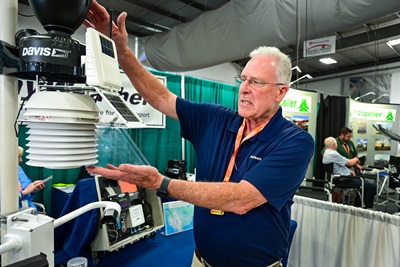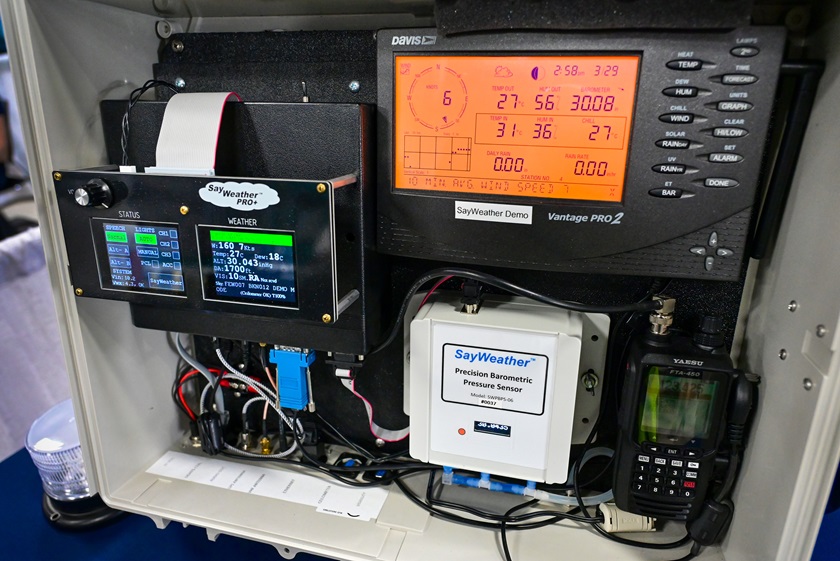SayWeather brings changing conditions to pilots' ears
Updated weather a few mic clicks away
Better situational awareness without multiple distractions is the hallmark of SayWeather, a new automated and audible weather reporting system for general aviation pilots.
Four clicks of a radio mic push-to-talk button on the unicom frequency delivers advisory weather to VHF transceivers for pilots flying near thousands of private and public airfields that lack automatic terminal information service (ATIS), automated weather observing system (AWOS), or other weather advisories.
He estimated about 8,000 to 9,000 GA airports lack on-site weather reporting stations, so the professional engineer developed an affordable solution for private airfields, aviation communities, and county- and city-run airports currently lacking weather reporting stations.
“AWOS is an expensive alternative, and many airports cannot afford it,” Langebrake said. “This weather technology can bring weather awareness to those airports.”
The wireless, solar-powered weather station includes an anemometer, wind vane, and temperature and dewpoint sensors mounted to a vertical light pole set into the ground. He estimated the weather array can be installed for as little as $100 to $500, depending on the complexity and location.
There is no charge to pilots using the weather updates. Airports pay $8,995 to install the turnkey system and $79 for a monthly subscription that monitors wind, gusts, altimeter, temperature, dewpoint, and density altitude. Visibility measurement equipment can be added for additional charges.
The SayWeather sensors may be installed anywhere within one mile of a SayWeather reporting unit, which contains equipment that broadcasts the information on demand to the unicom frequency. The devices have been available for about five years and gaining steam with “about 100 in the U.S.” and several weather stations in other countries.

A handful of companies provide and service FAA-certified automatic weather reporting facilities that allow pilots to use the information for instrument approaches. For comparison, a 2014 AWOS cost-benefit analysis by the port of Port Townsend, Washington, calculated installation cost between $120,000 to $460,000, with additional annual maintenance and expenses of about $15,000.
Langebrake said VFR pilots may use the local weather gathering info “at their discretion” in an advisory-only capacity, but cautioned instrument pilots not to count on it for IFR approaches because it’s not yet certified for IFR operations in the lower 48.
He said the SayWeather system is ideal for pilots concentrating on see-and-avoid techniques in the landing and takeoff phases at airports without weather reporting because they can hear the conditions broadcast into headsets instead of looking down or away at weather text displayed on portable devices or other avionics. A typical broadcast lasts about 15 seconds or less. There is a fail-safe one-minute timeout in case a mic key gets stuck, but Langebrake said that hasn’t yet happened.
Airport weather is continuously published to the cloud, and pilots using popular aviation apps can size up conditions ahead of time via text or while approaching specific airfield weather stations, in addition to the audio alerts.
In practical use, up-to-date wind and density altitude information is especially helpful to pilots navigating gusty and changing conditions at widely spaced airports in the Pacific Northwest, the Rocky Mountains, and the Great Plains, and other facilities lacking traditional weather reporting capability.
“The great thing about SayWeather is that it’s updated continuously so you’ll get current METAR information instead of once-per-hour updates” contained in a traditional ATIS report, Langebrake said. A customized, dedicated webpage is posted for each airport. It includes an updated weather page, barometric weather trends, a graphic depiction of the wind direction, and other weather data.
Light sport pilots using the Paradise City area of Lakeland Linder International Airport’s grass runway had access to a SayWeather outpost broadcasting current conditions during the Sun ’n Fun Aerospace Expo.
“We’re pretty excited it’s a good solution for airports without weather reporting features,” Langebrake said. “The bottom line is that you can get AWOS-quality weather information at a fraction of the cost.”





